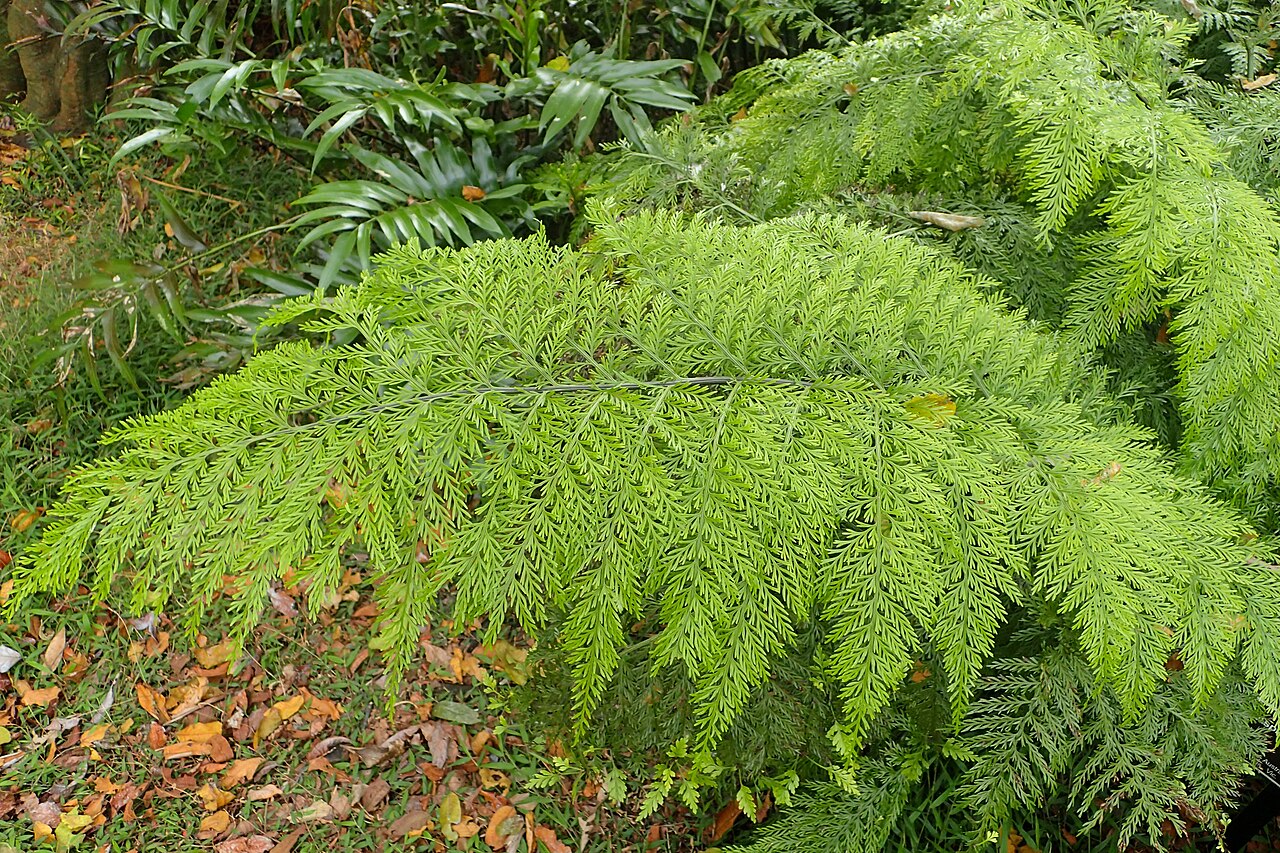Kiokio (Palm-leaf Fern)
Blechnum novae-zelandiae
Blechnum novae-zelandiae, commonly known as Kiokio or Palm-leaf Fern, is one of New Zealand's most common and distinctive native ferns. With its upright growth habit and striking fronds that emerge in vibrant red-pink colors before maturing to deep green, this adaptable fern creates a dramatic presence in a variety of habitats from coastal areas to mountain slopes. Its versatility and visual appeal make it both an ecological cornerstone and a popular landscaping choice. The ecological significance of Kiokio in New Zealand's diverse ecosystems cannot be overstated.

Image credit: Wikipedia
Quick Facts
| Height | 0.5-1.5 meters |
|---|---|
| Water Needs | Moderate to high |
| Light | Partial shade to full shade |
| Frost Tolerance | High |
| Growth Rate | Moderate |
| Lifespan | Long-lived perennial |
Climate Best Suited To
Kiokio is remarkably adaptable and grows throughout New Zealand from coastal areas to subalpine zones. It thrives in moist, shaded environments but can tolerate a wide range of conditions including exposed sites once established. Its versatility makes it suitable for most regions of New Zealand.
Regional Suitability
| City | Climate Suitability |
|---|---|
| Whangārei | Ideal |
| Auckland | Ideal |
| Hamilton | Ideal |
| Tauranga | Ideal |
| Rotorua | Ideal |
| Gisborne | Ideal |
| New Plymouth | Ideal |
| Napier | Ideal |
| Whanganui | Ideal |
| Palmerston North | Ideal |
| Wellington | Ideal |
| Nelson | Ideal |
| Christchurch | Ideal |
| Dunedin | Ideal |
| Invercargill | Ideal |
Growing Requirements
Soil Requirements
Kiokio performs best in the following soil conditions:
- Moist, humus-rich soil
- Good drainage while retaining moisture
- Slightly acidic to neutral pH (5.5-7.0)
- Tolerates a range of soil types including clay
- Benefits from added organic matter
Light Requirements
This fern is adaptable to various light conditions:
- Prefers partial to full shade
- Can tolerate morning sun or dappled light
- Avoid hot afternoon sun, especially in warmer regions
- More sun tolerance in cooler, humid climates
- Young fronds may burn in direct sunlight
Water Requirements
Kiokio has moderate to high water needs:
- Keep soil consistently moist, especially when establishing
- More drought-tolerant than many other ferns once established
- Benefits from regular watering during dry periods
- Mulching helps retain soil moisture
- Avoid waterlogged conditions
Temperature Tolerance
Kiokio is hardy across a wide temperature range:
- Frost hardy to at least -5°C (23°F)
- Fronds may die back in severe frost but will regrow
- Prefers cool to moderate temperatures
- May need extra water during hot periods
- Can grow from coastal to subalpine environments
Understanding the growing requirements of Kiokio is crucial not only for successful cultivation but also for appreciating its ecological significance. These requirements reflect its natural habitat preferences and demonstrate why it plays such a vital role in New Zealand's ecosystems. The ecological significance of Kiokio is particularly evident in its ability to thrive across diverse environmental conditions.
Uses & Significance
Garden Uses
- Shade gardens
- Woodland settings
- Stream and pond margins
- Erosion control on banks
- Container planting
Traditional Māori Uses
- Known as "kiokio" in te reo Māori
- Young unfurling fronds (koru) were occasionally eaten after cooking
- Fronds used for bedding material
- Used medicinally for treating boils and skin infections
- Rhizomes sometimes used to treat internal ailments
- Served as a calendar plant, with new growth indicating seasonal changes
Ecological Significance
- Important pioneer species in disturbed areas
- Helps stabilize soil on banks and slopes
- Provides habitat for small native insects and invertebrates
- Contributes to understory diversity in forest ecosystems
- Tolerates a wide range of conditions, making it resilient to environmental changes
Seasonal Care Calendar
Spring Care
- Watch for new fronds emerging, which often have attractive red-pink coloration
- Apply a slow-release organic fertilizer if desired
- Mulch with leaf mold or compost to retain moisture
- Remove any winter-damaged fronds
- Divide established plants if needed
- Monitor for slugs and snails, which may damage new growth
Summer Care
- Ensure consistent moisture, especially during dry periods
- Apply additional mulch if needed to conserve moisture
- Provide protection from hot afternoon sun
- Remove any damaged or diseased fronds
- Watch for pests like scale insects
- Avoid fertilizing during very hot weather
Autumn Care
- Reduce watering as temperatures cool
- Plant or transplant Kiokio before the first frost
- Apply a fresh layer of mulch for winter protection
- Collect spores if desired for propagation
- Remove any damaged fronds but leave the healthy ones
- Clean up fallen debris around plants to prevent disease
Winter Care
- Reduce watering to minimal levels
- Protect from severe frost in colder regions
- Avoid removing fronds even if they brown, as they provide protection
- Check occasionally for water needs during dry winter periods
- Plan for spring division or new plantings
- Avoid walking on frozen ground around ferns
Pruning Information
Kiokio does not typically require pruning, as it naturally sheds old fronds and produces new ones. However, if necessary, you can remove damaged or diseased fronds to promote healthy growth.
Planting Guide
When to Plant
The best time to plant Kiokio is during the following seasons:
Spring and autumn are ideal planting times, allowing the fern to establish before summer heat or winter cold.
Where to Plant
Kiokio is versatile and can be planted in various locations:
- Shaded garden borders
- Woodland gardens and ferneries
- Stream and pond margins
- Under tree canopies
- Shaded slopes for erosion control
- Native plant gardens
- Large containers in shaded areas
How to Plant
- Prepare the planting area by removing weeds and incorporating organic matter
- Dig a hole twice as wide as the root ball and at the same depth
- Position the fern at the same level it was growing previously
- Backfill with soil, firming gently around the roots
- Water thoroughly after planting
- Apply a 5-7cm layer of mulch, keeping it away from the crown
- Space plants 60-100cm apart to allow for growth
Companion Plants
Kiokio pairs well with these native New Zealand plants:
- Astelia species (Bush Flax)
- Coprosma species (especially low-growing forms)
- Libertia species (New Zealand Iris)
- Carex species (Sedges)
- Phormium cookianum (Mountain Flax)
- Other native ferns like Asplenium bulbiferum (Hen and Chicken Fern)
- Fuchsia excorticata (Tree Fuchsia) for dappled shade
Propagation Methods
Division
The most reliable method for propagating Kiokio:
- Best performed in spring or early autumn
- Dig up the entire clump carefully
- Divide the rhizome into sections using a sharp knife
- Ensure each division has several fronds and healthy roots
- Replant divisions at the same depth as before
- Water thoroughly and keep consistently moist
- Provide shade until new growth appears
Spores
A slower but rewarding method:
- Collect mature fronds with dark spore cases (sori) on the underside
- Place fronds on clean paper in a dry place to release spores
- Prepare a sterile growing medium of peat and perlite
- Sprinkle spores thinly over the surface
- Cover with glass or plastic to maintain humidity
- Keep at 18-21°C (65-70°F) in indirect light
- Mist with distilled water to maintain moisture
- Prothalli will form in 1-3 months
- Young ferns will develop in 6-12 months
- Transplant when several fronds have formed
Rhizome Cuttings
An alternative method for propagation:
- Cut sections of rhizome about 10cm long
- Ensure each section has at least one growth point
- Allow cut ends to callus for a few hours
- Plant horizontally in a mix of peat and perlite
- Cover with 1-2cm of growing medium
- Keep consistently moist but not waterlogged
- Maintain high humidity until new growth appears
- Transplant once well-established
Cultural History
Kiokio has a significant place in New Zealand's natural and cultural heritage:
Traditional Māori Uses
- Known as "kiokio" in te reo Māori
- Young unfurling fronds (koru) were occasionally eaten after cooking
- Fronds used for bedding material
- Used medicinally for treating boils and skin infections
- Rhizomes sometimes used to treat internal ailments
- Served as a calendar plant, with new growth indicating seasonal changes
Ecological Significance
- Important pioneer species in disturbed areas
- Helps stabilize soil on banks and slopes
- Provides habitat for small native insects and invertebrates
- Contributes to understory diversity in forest ecosystems
- Tolerates a wide range of conditions, making it resilient to environmental changes
European Settlement Impact
- Recognized early by European botanists for its distinctive appearance
- Maintained populations despite land clearance due to its adaptability
- Became popular in Victorian-era fern collections
- Specimens sent to European botanical gardens
Contemporary Significance
Today, Kiokio is valued both for its ecological role and as an ornamental plant in gardens. Its adaptability makes it an excellent choice for landscaping with native plants, and its distinctive appearance with red-pink new growth provides visual interest. Conservation efforts include using it in revegetation projects and stream bank stabilization, where its robust nature helps establish native plant communities in disturbed areas.
Pests & Diseases
Common Pests
- Slugs and Snails: Can damage new fronds. Control with organic baits, copper tape, or beer traps.
- Scale Insects: May appear on fronds as small bumps. Remove with cotton swab dipped in alcohol or use horticultural oil.
- Caterpillars: Occasionally feed on fronds. Hand-pick or use organic Bacillus thuringiensis spray if infestation is severe.
- Mealybugs: Sometimes infest the crown and base of fronds. Treat with insecticidal soap or neem oil.
Common Diseases
- Root Rot: Caused by overwatering or poor drainage. Ensure well-draining soil and avoid waterlogged conditions.
- Fungal Leaf Spots: Various fungi can cause spotting on fronds. Improve air circulation and avoid overhead watering.
- Rust: Appears as orange or brown spots on fronds. Remove affected fronds and improve air circulation.
- Crown Rot: Often results from water sitting in the crown. Avoid overhead watering and ensure good drainage.
Environmental Issues
- Sunburn: Direct sunlight causes yellowing and browning of fronds. Move to a more shaded location.
- Frost Damage: Severe frosts can damage fronds. Fronds may die back but will regrow from the crown in spring.
- Wind Damage: Strong winds can tatter fronds. Plant in sheltered locations or provide windbreaks.
- Drought Stress: Extended dry periods cause frond edges to brown. Increase watering and apply mulch.
Kiokio is generally resilient to pests and diseases when grown in appropriate conditions. Good cultural practices including proper spacing, appropriate watering, and good air circulation will prevent most problems. This fern is more tolerant of environmental stresses than many other fern species, making it relatively low-maintenance.
Bonus Tip
To highlight the spectacular red-pink coloration of new Kiokio fronds, position your plants where they'll be backlit by morning or evening sun. This creates a stunning translucent glow as light passes through the new growth. This effect is particularly dramatic in spring when multiple new fronds are emerging. Consider planting Kiokio on the east or west side of a garden where this natural backlighting will occur at sunrise or sunset.


